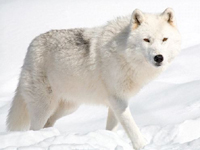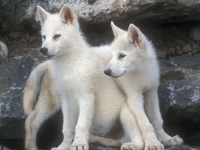

 |

|
 Arctic Wolf |
Arctic Wolf(Mammal) |
 Arctic Wolf Baby |
Arctic Wolf HabitsArctic wolves inhabit some of the most inhospitable terrain in the world. In April, the air temperature rarely rises above -22 F . The ground permanently frozen. The arctic wolf is one of the few mammals that can tolerate these conditions.
The Wolf preys on lemmings and arctic hare, but its most substantial source of food is the musk ox and caribou. Because of the scarcity of grazing plants, animals must roam a large area in order to find enough food to survive. Consequently, the wolf pack has to travel over areas of up to 800 square miles in search of its prey.
When winter temperatures plummet, the wolves may follow migrating caribou south. |
Arctic Wolf CommunicationWolves use body language to convey the rules of the pack and rule number one says that the pack is made up of leaders and followers. The dominant male and female are in charge of the pack. To communicate dominance, they carry their tails high and stand tall. Less dominant wolves exhibit submissive behavior by holding their tails down and often lower their bodies while pawing at the higher-ranking wolves. The pack has a complex social hierarchy maintained through a variety of vocalizations, body postures, and scent marking. |
Arctic Wolf BreedingThroughout the fall and winter, wolves keep on the move, but after mating in March, the pregnant female leaves the pack to find a nursery den. She may dig a new one, but where the ground is frozen, she will be forced to return to an old den in a cave or rock cleft.
The cubs are born deaf, blind, and helpless. They are totally dependent on their mother, and she in turn relies on her mate to bring her the food she needs.
After a month, the cubs are able to eat meat. From then on, the whole pack shares the job of feeding them with regurgitated meat from a kill.
The cubs may strike out on their own the following year. |
Arctic Wolf Food & FeedingFull grown caribou and musk oxen are far too powerful for a single wolf to attack alone, so wolves must always work together as a pack when hunting large prey.
Surprise attacks are almost impossible on the open tundra; by the time the pack approaches, its prey is in a defensive stance. Musk oxen, for example, will form a circle with their calves safely on the inside. The wolf pack must then try to disrupt the herd.
The wolves circle the herd and prowl around, forcing the oxen to shift their ground to face them. If the wolves are successful, the oxen scatter.
Once the herd has scatter, the wolves give chase, trying to isolate a young or weak animal. If one wolf catches a victim, the other will aid in killing it. A musk ox provides enough food to last the wolves for several days. |
Arctic Wolf Key Facts |
| Size |
| Height: To shoulder, 25-31 inches. Head and body, 3-5 feet |
| Weight: Up to 175 lb. Female, lighter |
| Breeding |
| Sexual maturity: Males 3 years. Females 2 years |
| Mating: March |
| Gestation: 61-53 days |
| Number of young: Usually 4-5 |
| Lifestyle |
| Habit: Lives in family groups of up to 30, but usually 7-10 |
| Diet: Mainly arctic hares, musk ox, caribou, and lemmings |
| Lifespan: 7 years on average |
DID YOU KNOW?
|
CAN'T FIND WHAT YOU'RE LOOKING FOR? CLICK HERE!!!